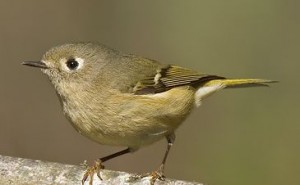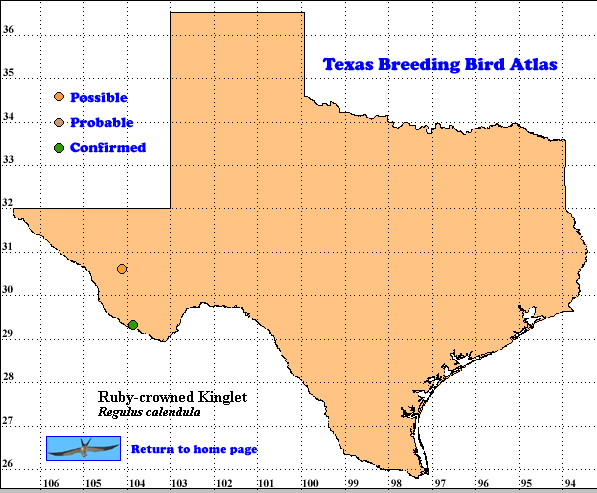Ruby-crowned Kinglets, plump little birds with lovely songs during the breeding season, are often seen plucking small insects from the foliage of trees as they hover. This is a characteristic feeding technique in both winter and summer.
Although still classified as a member of the genus Regulus, recent studies suggest this kinglet is more closely related to the leaf warblers of the Old World (genus Phylloscopus) which includes the Arctic Warbler (P. borealis; Ingold and Wallace 1994).
DISTRIBUTION. During the 1987-1992 field work of the TBBA project volunteers found 2 breeding records for Ruby-crowned Kinglet in the Trans-Pecos region, a possible in 30104 (the Davis Mountains) and a confirmed in 29103. These records are puzzling since Lockwood and Freeman (2004) do not report any breeding records for this species in Texas and Oberholser (1974) does not show any sumer records on his map..
In North America, this kinglet breeds in the cool boreal and higher elevation coniferous forests of Alaska, Canada and the contiguous 48 United States. Populations in Alaska, Canada, the northeastern United States, the northern and central Rocky Mountains and the Cascades and Sierra Nevadas move south or to lower elevations. In winter this kinglet is found in parts of British Columbia, Washington, Idaho, Oregon, California, Nevada, Utah, Colorado, Arizona, New Mexico, the southern and mid-Atlantic states, Baja California and mainland Mexico south to the Isthmus of Tehuantepec Ingold and Wallace 1994, Howell and Webb 1995).
SEASONAL OCCURRENCE. Ruby- crowned Kinglets generally arrive as fall migrants and winter residents in Texas in mid-September and depart for the north by early May. Some have been found as early as August 23 and a few individuals were still present May 30.(Oberholser 1974, Lockwood and Freeman 2004). In Arizona confirmed breeding evidence was obtained in June and July (Wise-Gervais 2005).
BREEDING HABITAT. In Arizona, where forests are similar to those of the Trans-Pecos, atlasers found Ruby-crowned Kinglets breeding most commonly in the coolest fir and spruce-fir forests and generally avoiding drier open ponderosa pine forests (Wise-Gervais 2005). In Colorado about 70% of breeding was found in the higher elevation conifer forests (Barret 1998).
The female builds the nest in about 5 days. It is placed high in a fir or spruce tree, usually attached to a small twig under a horizontal branch in heavy foliage. The deep cup, as large as 10 cm (4 in) wide, 10-12 cm (4-5 in) deep is made of moss, twigs, feathers, conifer needles, lichens, rootlets, grasses and spider silk, lined with feathers, fine grasses, plant down and animal hair.
The female usually lays 7-10 (range 4-12) smooth, dull, white eggs (see Harrison [1979] for photo of markings). The eggs are indistinguishable from those of Golden-crowned Kinglet (R. satrapa). The female, completely hidden in the deep nest, incubates the eggs for about 2 weeks. The young leave the nest about 16 days after hatching (Harrison 1979, Ingold and Wallace 1994).
STATUS. Ruby-crowned Kinglets are common to abundant migrants and winter residents throughout Texas (Lockwood and Freeman 2004). North American Breeding Bird Survey data from 756 routes across the United States and Canada provide a statistically significant -0.9% population change per year for the period 1966-2005 (Sauer et al. 2005). This small population trend suggests that this species will continue as a member of the Texas avifauna in the future.
Text by Robert C. Tweit (2006)
Literature cited.
Barret, N. M.. 1998. Ruby-crowned Kinglet (Regulus calendula). In Colorado breeding bird atlas, pp. 378-379 (H. E. Kingery. ed.), Colorado Bird Atlas Partnership, Denver.
Harrison, H. H. 1979. A field guide to western birds’ nests. Houghton Mifflin, Boston, MA.
Howell, S. N. G. and S. Webb. 1995. A guide to the birds of Mexico and northern Central America. Oxford University Press, New York.
Ingold, J. L. and G. E. Wallace. 1994. Ruby-crowned Kinglet (Regulus calendula). In The birds of North America, No. 119 (A. Poole and F. Gill, eds.). The Birds of North America, Inc., Philadelphia, PA.
Lockwood, M. W. and B. Freeman. 2004. The TOS handbook of Texas birds. Texas A&M University Press, College Station.
Oberholser, H. C. 1974. The bird life of Texas. University of Texas Press, Austin.
Sauer, J. R., J. E. Hines, and J. Fallon. 2005. The North American Breeding Bird Survey, results and analysis 1966-2005. Version 6.2 2006. USGS Patuxent Wildlife Research Center, Laurel MD < http://www.mbr-pwrc.usgs.gov/bbs>
Wise-Gervais, C. 2005. Ruby-crowned Kinglet (Regulus calendula). In Arizona breeding bird atlas. pp. 420-421 (T. E. Corman and C. Wise-Gervais, eds.). University of New Mexico Press, Albuquerque.

